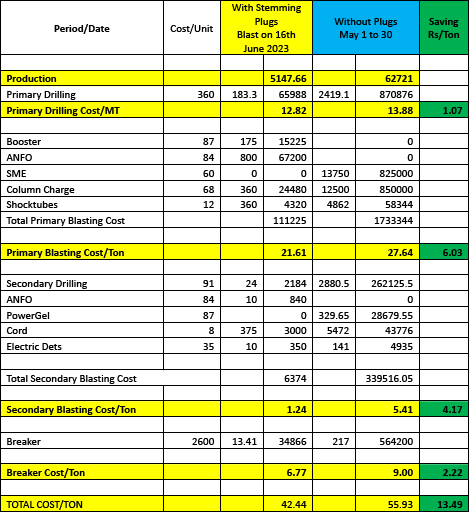
Improper and uneven use of explosive energy results in uneven fragmentation, Boulders and dust, both of which are difficult to deal with. Boulders need secondary breakage and dust is a wastage.
Stemming is the most critical part of blast geometry; inadequate stemming results in Flyrock, and too small a portion produces boulders needing secondary blasting.
The solution lies in better utilisation of explosives energy before it reaches the top portion of the hole and containing the explosives energy a little longer. This also ensures that material is thrown in the forward direction thus giving good quality of muck pile.
The solution is the use of stemming plugs.
Stemming plugs are forced to fit into the blast hole at the predetermined location. The location of the placement should be such that it results in an air deck of enough height.
When explosives are initiated at the bottom, the air deck gets compressed, stemming plug being flexible resists this pressure for a few milliseconds diverting the energy towards the free face, resulting in better fragmentation and throw.

1. Storage: Store boxes in a dry area to prevent premature deterioration of the packaging.
2. Transport and Handling: The stemming plug is not classified as a dangerous good for transport, storage, and handling and can be shipped and stored as general cargo. It is made of Resilient, Flexible material such as PVC Urethane, Rubber or similar material moulded and has a virtually infinite shelf life if stored correctly with intact packaging.
3. Shape Maintenance: If the plug has distorted during shipping and/or storage, stretch the plug back into shape.
4. Loading with Emulsion Explosive: If an emulsion explosive has been loaded, wait for at least 30-45 minutes for the emulsion to gas before loading the stemming plug. Loading prematurely can cause ‘dead pressing’ of the explosive, preventing it from achieving the correct detonation characteristics or preventing detonation altogether.
5. Deployment: Use a stemming rod long enough to push the plug into position. The correct stemming height generally ranges from the bottom charge height + 0.7 to 1m airdeck, depending on the quality of the stemming material, presence of water in the top portion of the hole, powder factor, rock strength in the upper flitch, and burden. The depth should be clearly indicated on the pole for the operator’s benefit, ensuring consistency from hole to hole across the shot.
5. Positioning:
6. Wet Ground: In wet ground, water will be displaced by the stemming material. When tamping the stemming material, especially if it consists of drill cuttings or a significant percentage of drill cuttings, take extreme care not to cause any damage to down lines and cords in the stemming area. Only trained and experienced operators should perform this task.
7. Using Liners: If liners are used in wet and/or badly cracked ground, push the liner to one side before placing the plug in the collar. Carefully push the plug into position and ensure the stemming is well-tamped to increase ejection resistance when using liners.
8. Final Inspection: After stemming has been loaded and during final inspection prior to firing the shot, ensure all holes are stemmed to surface level at least, and no holes show signs of subsidence of the stemming material. Subsidence can occur when drill cuttings are used as stemming in wet ground or if the stemming plug has moved. Any change to the downlines (such as increased tension or evidence of movement) should be carefully remedied or at least recorded in case it is relevant to any post-blast analysis.
Contact crm@uttamblastech.com to get commercial details of the above.
Check www.uttamblastech.com/resources for more information
Copyright 2024, UTTAM BLASTECH PVT LTD, Hyderabad